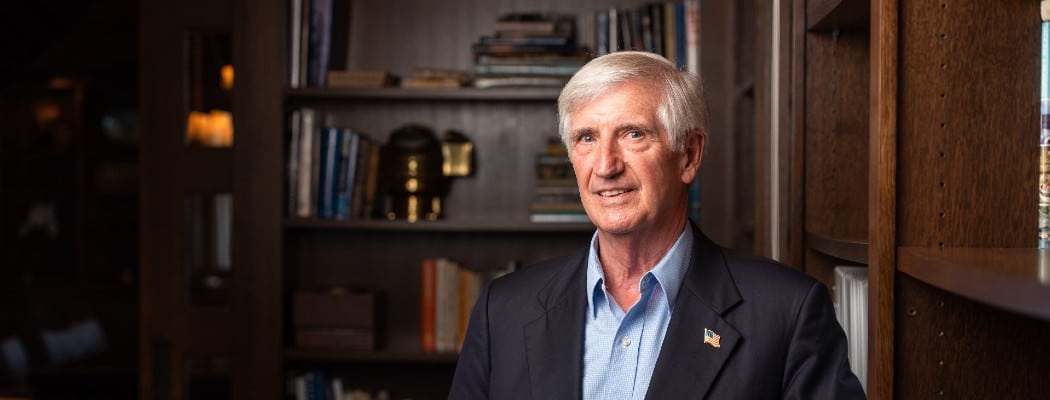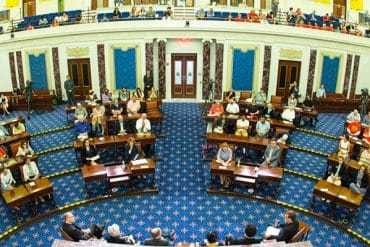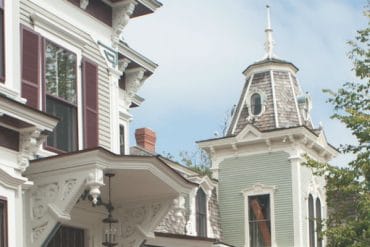Former Bush Chief of Staff Andy Card remembers the day that changed the country and the world.
Andy Card is the longest-serving presidential chief of staff in the past fifty years, holding the office for nearly six years under George W. Bush. Having also served in the administrations of Ronald Reagan and George H.W. Bush, he was widely recognized as a loyal and highly capable public servant. Raised in Holbrook, Massachusetts, where he met his wife, Kathleene, of fifty-four years, Card has a straightforward and unvarnished delivery that belies a person whose innate political instincts and personal skills enabled him to navigate through some of the most complex and critical moments in modern history. Serving as chief of staff under a president who was praised by some and vilified by others, Card shared fascinating accounts of life with the president and most notably the drama surrounding the September 11th attacks.
 What was your first political experience?
What was your first political experience?
I was elected to the Planning Board of the Town of Holbrook right out of college with my engineering degree. I eventually ran for MA State Representative and got elected in 1974, representing Holbrook and Braintree in Massachusetts. I did that for two terms. Then I represented Holbrook, Abington and Whitman for two terms. I ran a forgettable campaign for governor of Massachusetts in 1982. After I came in third in the GOP Primary, I got a call from James A. Baker III, who was chief of staff to President Ronald Reagan. He invited me to come work at the Reagan White House.
What were your impressions of Reagan?
Ronald Reagan was a great communicator. He was also a very good listener and could translate what he was being told in such a way that made it more understandable for everybody else. I remember him being very comfortable and inviting to people.
Explain the next progression.
I was very close to George H.W. Bush when he first ran for president in 1980. I signed on in December 1978 as the volunteer chairman of his campaign in Massachusetts and got to work very closely with his sister Nan Ellis and came to know the Bush family pretty well. I ended up being his deputy White House chief of staff and in 1992 joined the Cabinet as secretary of transportation.
A lot of people did not take George W. Bush seriously. How did he transition from someone perceived as an undisciplined party boy to someone holding the most powerful office in the world?
I happened to have the privilege to be an infrequent but passionate observer of how George W. Bush came to be the man he is today. He is one of the most disciplined people I have ever met. I watched George W. Bush as he matured and helped himself by making decisions about his own life that were not easy decisions to make. He stopped drinking, got serious about exercising and got serious about having more discipline around his faith. I then watched as he took that personal discipline and brought it into his everyday life of making decisions in government in complement with his MBA training and experience as Texas governor.

Among the many things he did while in office, President Bush tried to prepare for a pandemic response if we had one. Were you involved with this?
We were very involved. There were new variants of flu and viruses coming out of China. And we paid attention to what we were getting in daily briefings from the health community, the Department of Health and Human Services and the Centers for Disease Control (CDC) and others. We were getting ready for the potential of N1 viruses, and the president on his own read articles and a book about the 1918 flu epidemic that happened to the United States and devastated Philadelphia and St. Louis. He devoured that book and said, “We’ve got to be ready for a pandemic.” So he convened the health experts in the Roosevelt Room of the West Wing of the White House. You had the head of the CDC, the head of the FDA, Tony Fauci was there, and the White House staffers that are involved in domestic policy. It was a very significant meeting. The president asked very good questions and challenged each one of the bureaucratic leaders that were there, saying, “We need to do something about it.”
What did he do?
He actually put together a plan and gave a speech over at the National Institutes of Health. He wanted to file legislation for Congress to get prepared for a pandemic and it was a very good bill. He sent a bill to Congress titled the National Strategy for Pandemic Preparedness, but it didn’t go anywhere. There was no appetite in Congress to deal with it. The president was frustrated, but we were not under “a threat,” or at least a known threat. But clearly it was the best roadmap out there for President Trump to be able to follow. And some of the people that helped develop that roadmap are involved with President Biden.
 Let’s talk about the defining moment of Bush’s presidency and the defining moment of your role as chief of staff. Explain the day leading up to Twin Towers being attacked.
Let’s talk about the defining moment of Bush’s presidency and the defining moment of your role as chief of staff. Explain the day leading up to Twin Towers being attacked.
We were in Sarasota, Florida, at the Colony Tennis and Golf Resort. On September 11th, I got up very early and went outside to check to see if we were doing the right things to get ready to go to a school. We were going to the Emma E. Booker Elementary School in Sarasota. The president was going to read a book with second graders and then address the community in an event at the school about education. We piled in the limousines to go over to the Emma E. Booker School. I do remember two people asking a question. One was Karl Rove, the other one was Dan Bartlett. “Did anybody hear about a plane crash in New York City?”
When did the president learn about the first plane?
We arrived at the school. We went into a classroom that had been converted to a White House command center with secure phones and the staff. The president went to a secure phone and called back to the White House to Condoleezza Rice, who was the national security advisor. I went into the classroom to make sure it was set up for the president to come in. I saw second graders lined up outside the door with their teacher. Then I walked into the holding room. I’m standing at the door to the classroom with the president and the principal of the school, and Deb Loewer, who was a Navy captain and acting national security advisor on the trip, came up to the president and said, “Sir, it appears a small twin-engine prop plane crashed into one of the towers of the World Trade Center in New York City.”

What was his reaction?
The president, the principal and I all had the same reaction: “What a horrible accident. The pilot must’ve had a heart attack or something.” With that, the principal opened the door to the classroom and the president and the principal walked into the classroom. The door shut. I’m still in the holding room. Captain Loewer comes up to me and said, “Sir, it appears it was not a small twin-engine prop plane; it was a commercial jetliner.” My mind flashed to the fear the passengers on the plane must’ve had. That was only a nanosecond, because Captain Loewer came up to me and said, “Oh my God, another plane hit the other tower at the World Trade Center.”
What was your first thought?
My mind flashed to three initials, UBL. Usama bin Laden. That’s what we called Osama bin Laden. I knew about the Al Qaeda network. I knew about Osama bin Laden. I knew about the attack on the World Trade Center in January 1993 and that it was organized by the Al Qaeda network.

How did you plan on telling the president?
I made a conscious decision to pass on two facts and make one editorial comment. I thought about what I would say. I did not want to do anything that would have the president ask me a question or start a dialogue, because I assumed he was sitting under a boom microphone.
I knew he was sitting in front of a press pool and second graders. I walked into the classroom. I came in from behind the president. The teacher was conducting a dialogue between the students and the president. As the students were reaching under the desks for their books to read with the President, I walked up to him. I leaned over and I whispered into his right ear, and he never turned fully around to me. He just kind of glanced towards me. I said, “A second plane hit the second Tower. America is under attack.”
The president continued to sit there for a few minutes?
He did not say anything to me. He did not get up. I was very pleased with how he reacted, because he did nothing to introduce fear to those second graders. He did nothing to demonstrate fear to the media that would have translated it to the satisfaction of the terrorists all around the world. The president was still facing forward, head bobbing up and down. I could tell he was really thinking about his responsibility.
What happened after President Bush left the school?
We’re in the back of the limousine. We call it the Beast. The president and I are sitting there. We’re both on our cell phones. I’m calling back to the Situation Room in Washington, D.C., and the president was trying to reach Secretary [Donald] Rumsfeld at the Pentagon. He’s very frustrated. “I can’t get anybody to answer the phone in the Pentagon.” It turns out that’s when the Pentagon was hit. We are arriving at the airfield in Sarasota to get on Air Force One. The limousine comes to a stop. The president is frustrated. I’m getting out of the limousine, and I’m struck by the sound of the engines on Air Force One running.

Why was that surprising?
The normal protocol is you don’t start the engines until the president is safely on the plane. I said to myself, “Mark Tillman [the pilot] must really want to get out of here.” We run up the gangplank and get on the plane. The plane starts rolling down the runway almost before the door has been shut, certainly before the president or I had taken our seat and put our seat- belts on. Mark Tillman was nervous that there could have been a stinger missile at the end of the runway. There was also a rumor—that proved not to be true—that because some communications had been picked up where someone used the term “angel”—“angel” is the code word for Air Force One—somebody thought maybe Air Force One was a target. There was a little bit of angst that floated around. We end up flying up to about 48,000 feet, and fighter jets were trying to catch up with us to protect us. Then the president says, “We’re going back to Washington D.C.” I said, “I don’t think you want to make that decision right now.”
We flew to Barksdale Air Force Base. The president had done some pretty remarkable things that he wasn’t even told to do. For example, one of the first things he did when he got on the plane, he says, “I want to call President Putin in Russia and make sure he doesn’t think we’re doing anything to start a war. We don’t want him to do anything stupid. I want to tell him what the situation is.” He called President Putin. It was a remarkable phone call. It was very brief, but I’m so glad that he did it. Also, we’re paying attention to what has happened at the Pentagon. We’ve got all this information coming in from Washington, D.C. The president is checking on making sure Laura’s all right, making sure the kids are all right, but he’s focused on his job and what else is happening. Are there other planes out there? I remember him receiving a phone call from the vice president. He was sitting at the desk. I was sitting right opposite him. I can hear the president’s side of the conversation. The president says, “Yes, I will authorize our fighter pilots to shoot down commercial jetliners if the jetliners are not responding to the FAA orders and landing.” I’ll never forget how the president hung up the phone after he said it. He said, “I was an Air National Guard pilot. I cannot imagine receiving that order.” Very soon after that, Flight 93 crashes into the ground in Shanksville, Pennsylvania. I will admit that I and others on Air Force One wondered, “Did we shoot it down?” We did not. All those conspiracy theorists out there—no, we did not, but it was a cause for angst for us.
What are your thoughts on Flight 93?
The first heroes in the War on Terror were the civilians on Flight 93. They’re the ones who found out about the attacks in New York because they called back to friends at home. They’re the ones that realized that their plane was going to be used as a weapon of mass destruction. When they said, “Let’s roll,” they probably saved the nation’s capital from being attacked— specifically the U.S. Capitol or the White House—and saved countless lives.
What was it like when the president visited Ground Zero?
We drove to Andrews Air Force Base, got on the spectacular 747 that became Air Force One as soon as the president got on it. We took off and we flew to Lakehurst up by Trenton, New Jersey, where the president was met by the governor of New York and the mayor of New York City. We then get on Marine One and fly out to the coast of New Jersey. The sky is strange because it was a beautiful day, but there are no planes in the sky. No planes coming up from JFK, LaGuardia, Liberty. No planes. And then you see her and she looks beautiful, the Statue of Liberty. The torch is glistening, and she’s spectacular. But then you see this pillar of black smoke coming out of the tip of Manhattan. Nobody in the helicopter is saying a word. And we circle around the pillar of smoke twice, all looking out the windows. It was just eerie and sad.

How did President Bush’s historic speech at Ground Zero come about?
The president says he wants to stop and get out. They stop the motorcade. He gets out. And we all get out. He is working down this crowd of people behind barricades. They’re all rescue workers. Some people are crying. Some people are cheering. He works his way down to what we call Ground Zero. The crowd is chanting, “U-S-A. U-S-A.” I see people hanging off of scaffolding. “U-S-A. U-S-A.” They’ve got Canadian flags on their uniforms, Japanese flags on their uniforms. And there’s this crushed vehicle. Karl Rove comes to me and says, “What are you thinking?” I said, “I’m going to ask him.” I asked a Secret Service [agent] and they sent a guy up there who jumped up and down on this crushed vehicle. He gives me the thumbs up. So I said, “Mr. President, would you be willing to get up on that and say something?” And he says to me, “Do you think it’s appropriate?” I said, “If you think it’s appropriate, it’s appropriate. If you don’t want to do it, you don’t have to do it. If you think it’s appropriate, you can do it.” An Advance person, Nina Bishop, finds a bullhorn. The President gets up there and he starts to talk. He’s got his arm around fireman Bob Beckwith. Somebody yells out, “I can’t hear you.” And the president says, “I can hear you. The rest of the world hears you. And the people who knocked these buildings down are going to hear all of us soon.” Everybody’s chanting, “U-S-A. U-S-A.” Unbelievably emotional. Literally at the time that was happening, Congress was voting virtually unanimously to go to war.
That same day, after he delivered the impromptu address, the president met with families of those fallen?
We went into the Jacob Javits Center, which is a huge convention hall. We drive right inside the building. There were teams of rescue workers from every state in the union and I think thirty-eight other countries coming in to help go through the rubble and try to find survivors. The president went to every one of them, took his picture with them, thanked them, rallied them and then gets back in the limousine. But we don’t leave the Jacob Javits Center. We go to another part of it.
The Secret Service opens the door. The president steps out and said, “What’s this?” The advance team says, “We’ve got a room set up here. There’s a podium at the front of the room. Thought you could stay for fifteen or twenty minutes, make some remarks to the people.” The president asks, “Well, who’s inside the room?” And [the advance team] says, “We’ve gathered some of the families of the policemen and firemen that are missing down at Ground Zero.” The president says, “I am not going to the podium.” He just barges into the room. He went to every single person in the room. There were tremendous emotions. There was tremendous hope. There was unbelievable fear, lots of tears, lots of prayers. The president went to literally every person. He stayed there for almost two hours.
When he’s getting ready to leave, a short, stocky woman stands up and looks up at him right in the eyes and holds out her hand. She said, “This is my son’s badge. His name is George Howard. Don’t ever forget him.” And the president puts his hand out. She drops the badge in the president’s hand. The president takes the badge and squeezes it. Tears are streaming down his cheeks. And all of us are crying. And the president says, “Mrs. Howard, America will forget. They’ll start to move on. But you don’t have to worry about me. I will never forget George Howard.”

Can you talk about the lead up to the invasion of Afghanistan and how Iraq got pulled into the equation?
On Saturday morning, 10 o’clock, Camp David, the president met with his national security team and all the players were there. The president said, “We’re going to war. I want to know what that means and how it’s going to work.” There was a very free-flowing discussion. It was very serious. I remember Paul Wolfowitz, who was deputy secretary of defense, spoke up and said, “Well, we’ve also got to worry about Saddam Hussein and Iraq.” And the president bristled. Some other people at the table did too. We broke for a bathroom break and the president said, “I don’t want to hear any talk about Iraq or Saddam Hussein. This is to deal with the problem that we have right now. So if Paul Wolfowitz brings it up again, he won’t be invited to any more meetings. I want you to tell him that.” The president was not interested in going to Iraq, not interested in taking on Saddam Hussein. He was keeping his word that those who harbored terrorists were going to be just as guilty as the terrorists. We were going to make sure that no terrorist could organize to perform the kind of task that they did on September 11th, 2001.
As we’re doing this interview, U.S. troops have left Afghanistan to be fully drawn down by the end of the month. Is this the way you thought the war in Afghanistan would finish?
I don’t think anyone anticipated that this war would last twenty years, but let’s not forget why we went in. Afghanistan was harboring terrorists, and they facilitated Al Qaeda’s attacks on the United States and several of our allies. The mission of the war was to make sure that Afghanistan would never be a safe haven for terrorists to plan attacks or carry them out. My concern today is that if we completely abandon, Afghanistan terrorist groups would try to find safe haven there. I also worry about all of the Afghan people who helped our troops during the war, many of whom were promised a chance to come to America. We also empowered women, brought them into the mainstream of the Afghan economy—even into its government—and certainly helped to give young women and girls an education. I want to make sure, as we leave, we keep our word, and that we do everything possible to make sure Afghanistan does not go backwards but goes forward.

You’re both an optimist and a realist. The country is incredibly fractured today. What is your perception of the state of our democracy?
I’m very troubled with the state of democracy. It became significantly more tarnished and probably dented on January 6th. I was in tears watching what happened. I was offended by what was happening. If you rationalize that as a good act, you are not rational. It’s irresponsible, inappropriate, and it damaged our democracy, but of even greater significance, it empowered others to resist democracy around the world. We’re the shining light on the hill. We’ve all got work to do. When I got involved in politics, the rug of American politics had more rug than fringe. Today, it has more fringe than rug. But you really cannot govern well, unless you have the courage to stand on the rug, recognizing that the thread on the left and the thread on the right go through the center of the rug. There is more common ground than we want to admit.
I feel strongly that the burden that we have is to listen to other people. And young people, please, please, please get involved and recognize the opportunity that this country has given us. We’re still a young country compared to a lot of other historic leading entities around the world. Our democracy is worth protecting. And it’s definitely in need of polish. Young people can polish it better than we can. If you’re twenty years old today, you were not around when 9/11 happened. Don’t forget what happened on 9/11. Those of us who were there promised never to forget. We don’t want you to fail to keep our promise. Make sure you put a pebble in your shoes on September 11th, so you’ll remember what happened that day and how many families are still carrying the burden.
This interview has been edited and condensed due to space limitations. Listen to the full discussion on a special edition of the Nantucket Sound podcast coming soon.







